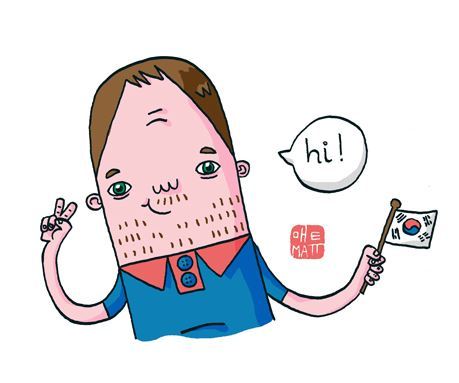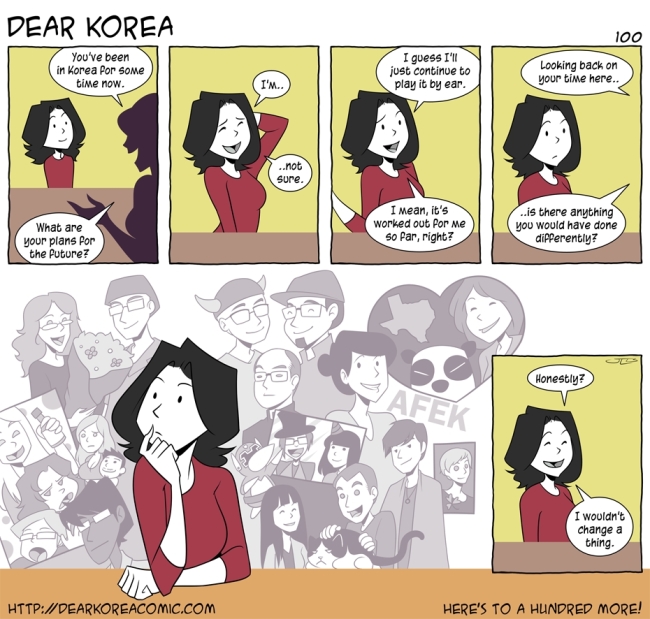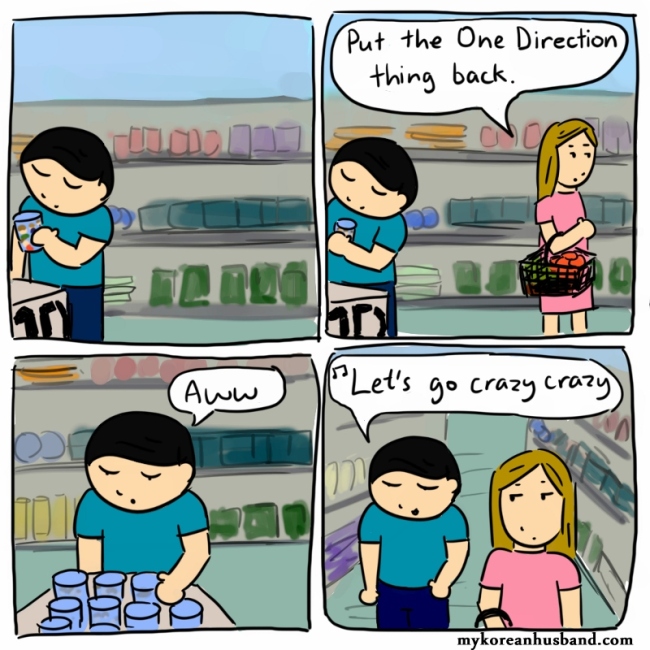
Blogging has long been a way for expats to relay their experiences to people back home or to each other. Sometimes negativity can worm its way into the sphere.
But comics, long an alternative to conventional blogging, are emerging as an outlet almost impervious to ridicule.
Nichola Gwon, the Australian behind “My Korean Husband,” who once worked as an artist, began cartoons last year when she wanted to start a blog.
The format helped her talk about a wider range of topics, she noted.
“People tend to take only words more seriously, but with a funny joke or situation in a comic it creates a relaxed environment that is good for discussion,” she said.

Other cartoonists have been drawing in the genre for a long time. “Dear Korea” is now in its third year, and its author Jen Lee said she has been drawing cartoons for as long as she can remember.
Kevin Kilgore began drawing in 1996 when stationed as a U.S. marine in Japan, and didn’t stop.
He first moved to Korea in 2003, where he drew a strip called “The Foreigner” for Akzine, a magazine that has won an award from the Korean government.
Since then, he has created various comics including “Ddongman,” featuring a character whose face is inspired by the spelling of the Korean word for poop.
There were a few things he wanted to vent about, he said, such as hallyu and the campaigns about the East Sea and Dokdo.
“It’s not that I’m against those things (well K-pop, yeah), it’s the way it’s pushed down your throat here,” he explained.
Kilgore started one of his newer projects, “Things I Love About Korea,” in a conscious effort to avoid the negativity that can set in on expat blogs.
“It’s so easy to start complaining about life in Korea, especially when you’ve been here for a while,” he said. “So, I figured I’m here for a reason, and I must like it here, so why not draw about that?”
For Gwon, her cartoon was partly in reaction to negative views that were already online.
“I realized when I researched ‘Korean husband’ online, the top search results were really negative things. It made me sad that this was all that came up for people researching about what it’s like to be married to a Korean man, especially as I was enjoying such a great relationship with my Korean husband,” she said.
“I decided to make a blog about being married to a Korean man that was positive and fun. I knew people responded best to images, rather than just a lot of text, so I decided comics was a good idea.”
Despite this, the depictions of Korea are not always flattering.
Jen Lee says she deliberately avoids controversial topics. But “Dear Korea” still contains digs at bus drivers, office drinking culture and the surplus of attention from strangers that sometimes comes with carrying a baby.
Kevin Kilgore began drawing in 1996 when stationed as a U.S. marine in Japan, and didn’t stop.
He first moved to Korea in 2003, where he drew a strip called “The Foreigner” for Akzine, a magazine that has won an award from the Korean government.
Since then, he has created various comics including “Ddongman,” featuring a character whose face is inspired by the spelling of the Korean word for poop.
There were a few things he wanted to vent about, he said, such as hallyu and the campaigns about the East Sea and Dokdo.
“It’s not that I’m against those things (well K-pop, yeah), it’s the way it’s pushed down your throat here,” he explained.
Kilgore started one of his newer projects, “Things I Love About Korea,” in a conscious effort to avoid the negativity that can set in on expat blogs.
“It’s so easy to start complaining about life in Korea, especially when you’ve been here for a while,” he said. “So, I figured I’m here for a reason, and I must like it here, so why not draw about that?”
For Gwon, her cartoon was partly in reaction to negative views that were already online.
“I realized when I researched ‘Korean husband’ online, the top search results were really negative things. It made me sad that this was all that came up for people researching about what it’s like to be married to a Korean man, especially as I was enjoying such a great relationship with my Korean husband,” she said.
“I decided to make a blog about being married to a Korean man that was positive and fun. I knew people responded best to images, rather than just a lot of text, so I decided comics was a good idea.”
Despite this, the depictions of Korea are not always flattering.
Jen Lee says she deliberately avoids controversial topics. But “Dear Korea” still contains digs at bus drivers, office drinking culture and the surplus of attention from strangers that sometimes comes with carrying a baby.

“My Korean Husband” often depicts the kind of bickering one-upmanship seen in cartoons like “Penguin Loves Mev,” a similar webtoon on Naver by a Korean woman married to a British man.
James Broadhurst, who runs a webtoon called “Waegook in Hangook” about his experiences, points out that it is easy to stray into territory that gets a negative response.
“I have tried to stay away from anything too overtly negative, as I appreciate that my comic is mainly seen on a Korean website, and people might not like criticism from the outside,” said Broadhurst. “I did do one comic about plastic surgery (‘Eyes, Nose, Lips’) that was quite controversial, and that currently has the lowest score of all my comics ― 9.6 out of 10!”
But as this score suggests, Broadhurst, like the other cartoonists, says the feedback is generally positive.
“I think the fact that it’s a comic and that it’s these silly little characters with round bottoms that mean you don’t really get that negativity you might do with a regular blog,” he said. “You can get away with a lot if you wrap it up in a cute bow.”
Lee suggests that, while cartoons aren’t an easy option, cartoonists tend to receive less criticism.
“I think a lot of it is because writing can sometimes be fueled by personal opinions that may or may not resonate with readers the same way images do. It’s said that a picture is worth a thousand words, but the words that are heard may vary depending on the viewer.”
Cartoons can even reap dividends. Gwon has landed a book deal with a Korean publisher and hopes to expand that to an English-language book one day. Broadhurst, meanwhile, hopes that one day Naver will promote him to full-blown webtoon, and is working on a graphic novel.
Kilgore has met and worked with several respected cartoonists through his activities, and gotten paid gigs, including a job translating Korean comics and even an in-house TV program for Woori Bank.
He is now working on a series with an American cartoonist in Japan named Adam Pasion.
“We’re comparing and contrasting our lives as cartoonists, English teachers, fathers and husbands,” said Kilgore. “We’re also going to bring in guest cartoonists with connections to Korea and Japan and maybe try to open a dialogue between a few Korean and Japanese cartoonists.”
He is also working on a long story about a giant atomic penguin called MUJIGAE.
“It’s all a big experiment for me,” he says. “I’m used to having a comic finished in a couple of hours, but MUJIGAE is going to take over a year to complete.”
By Paul Kerry (paulkerry@heraldcorp.com)
James Broadhurst, who runs a webtoon called “Waegook in Hangook” about his experiences, points out that it is easy to stray into territory that gets a negative response.
“I have tried to stay away from anything too overtly negative, as I appreciate that my comic is mainly seen on a Korean website, and people might not like criticism from the outside,” said Broadhurst. “I did do one comic about plastic surgery (‘Eyes, Nose, Lips’) that was quite controversial, and that currently has the lowest score of all my comics ― 9.6 out of 10!”
But as this score suggests, Broadhurst, like the other cartoonists, says the feedback is generally positive.
“I think the fact that it’s a comic and that it’s these silly little characters with round bottoms that mean you don’t really get that negativity you might do with a regular blog,” he said. “You can get away with a lot if you wrap it up in a cute bow.”
Lee suggests that, while cartoons aren’t an easy option, cartoonists tend to receive less criticism.
“I think a lot of it is because writing can sometimes be fueled by personal opinions that may or may not resonate with readers the same way images do. It’s said that a picture is worth a thousand words, but the words that are heard may vary depending on the viewer.”
Cartoons can even reap dividends. Gwon has landed a book deal with a Korean publisher and hopes to expand that to an English-language book one day. Broadhurst, meanwhile, hopes that one day Naver will promote him to full-blown webtoon, and is working on a graphic novel.
Kilgore has met and worked with several respected cartoonists through his activities, and gotten paid gigs, including a job translating Korean comics and even an in-house TV program for Woori Bank.
He is now working on a series with an American cartoonist in Japan named Adam Pasion.
“We’re comparing and contrasting our lives as cartoonists, English teachers, fathers and husbands,” said Kilgore. “We’re also going to bring in guest cartoonists with connections to Korea and Japan and maybe try to open a dialogue between a few Korean and Japanese cartoonists.”
He is also working on a long story about a giant atomic penguin called MUJIGAE.
“It’s all a big experiment for me,” he says. “I’m used to having a comic finished in a couple of hours, but MUJIGAE is going to take over a year to complete.”
By Paul Kerry (paulkerry@heraldcorp.com)
-
Articles by Korea Herald









![[Hello India] Hyundai Motor vows to boost 'clean mobility' in India](http://res.heraldm.com/phpwas/restmb_idxmake.php?idx=644&simg=/content/image/2024/04/25/20240425050672_0.jpg&u=)









